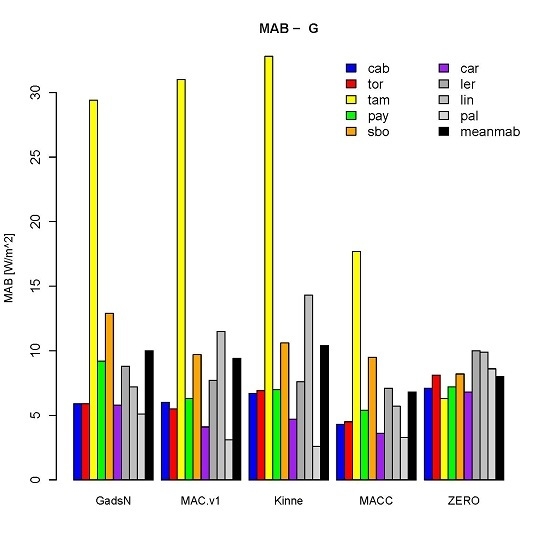Brief Accuracy Assessment of Aerosol Climatologies for the Retrieval of Solar Surface Radiation
Abstract
:1. Introduction
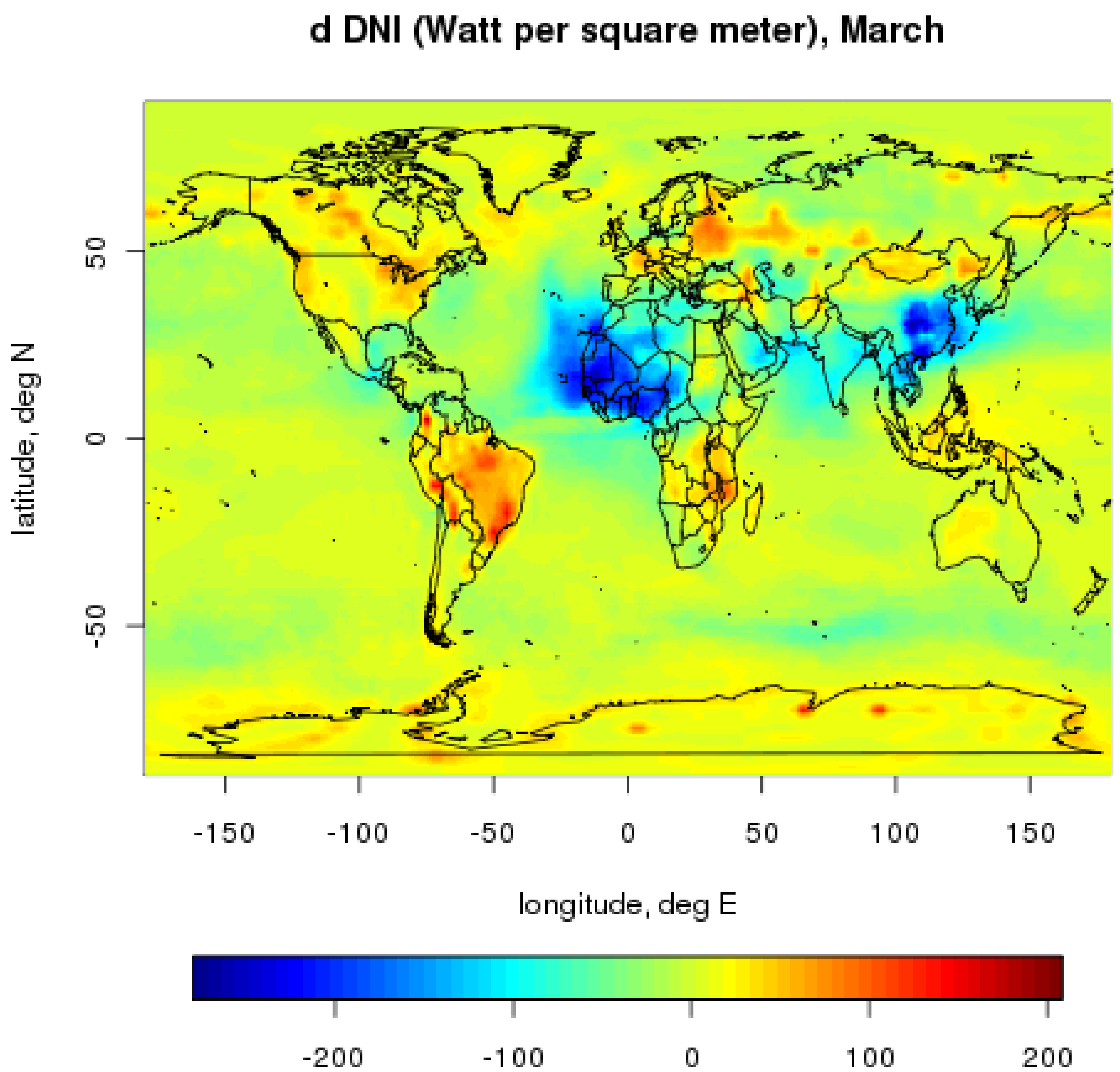
2. The Investigated Aerosol Data Sets
3. Results and Discussion
| Station | Country | Code | Latitude (DegN) | Longitude (DegE) | Elevation (m) | Number of Months |
|---|---|---|---|---|---|---|
| Palaiseau | France | pal | 48.73 | 2.21 | 156 | 16 |
| Lerwick | UK | ler | 60.13 | −1.18 | 84 | 13 |
| Lindenberg | Germany | lin | 52.21 | 14.12 | 125 | 12 |
| Carpentras | France | car | 44.05 | 5.03 | 100 | 48 |
| Payerne | Switzerland | pay | 46.81 | 6.94 | 491 | 48 |
| Sede Boger | Israel | sbo | 30.9 | 34.78 | 500 | 48 |
| Tamanrasset | Algeria | tam | 22.78 | 5.51 | 1385 | 48 |
| Toravere | Estonia | tor | 58.25 | 26.46 | 70 | 48 |
| Cabauw | Netherlands | cab | 51.97 | 4.93 | 0 | 48 |
| Variable | GADS/OPAC | MAC-v1 | Kinne | MACC | Zero Trop. Aerosol |
|---|---|---|---|---|---|
| MAB G in W/m2 | 10.0 | 9.4 | 10.4 | 6.8 | 8.0 |
| in % | 5.4 | 5.0 | 5.5 | 3.8 | 5.1 |
| MAB B in W/m2 | 14.6 | 14.8 | 17.1 | 11.3 | 25.8 |
| in % | 12.8 | 12.7 | 14.9 | 9.9 | 23.9 |
| Bias G in W/m2 | −7.4 | −7.0 | −8.4 | −4.0 | 5.4 |
| Bias B in W/m2 | −10.5 | −11.7 | −14.7 | −7.6 | 24.6 |
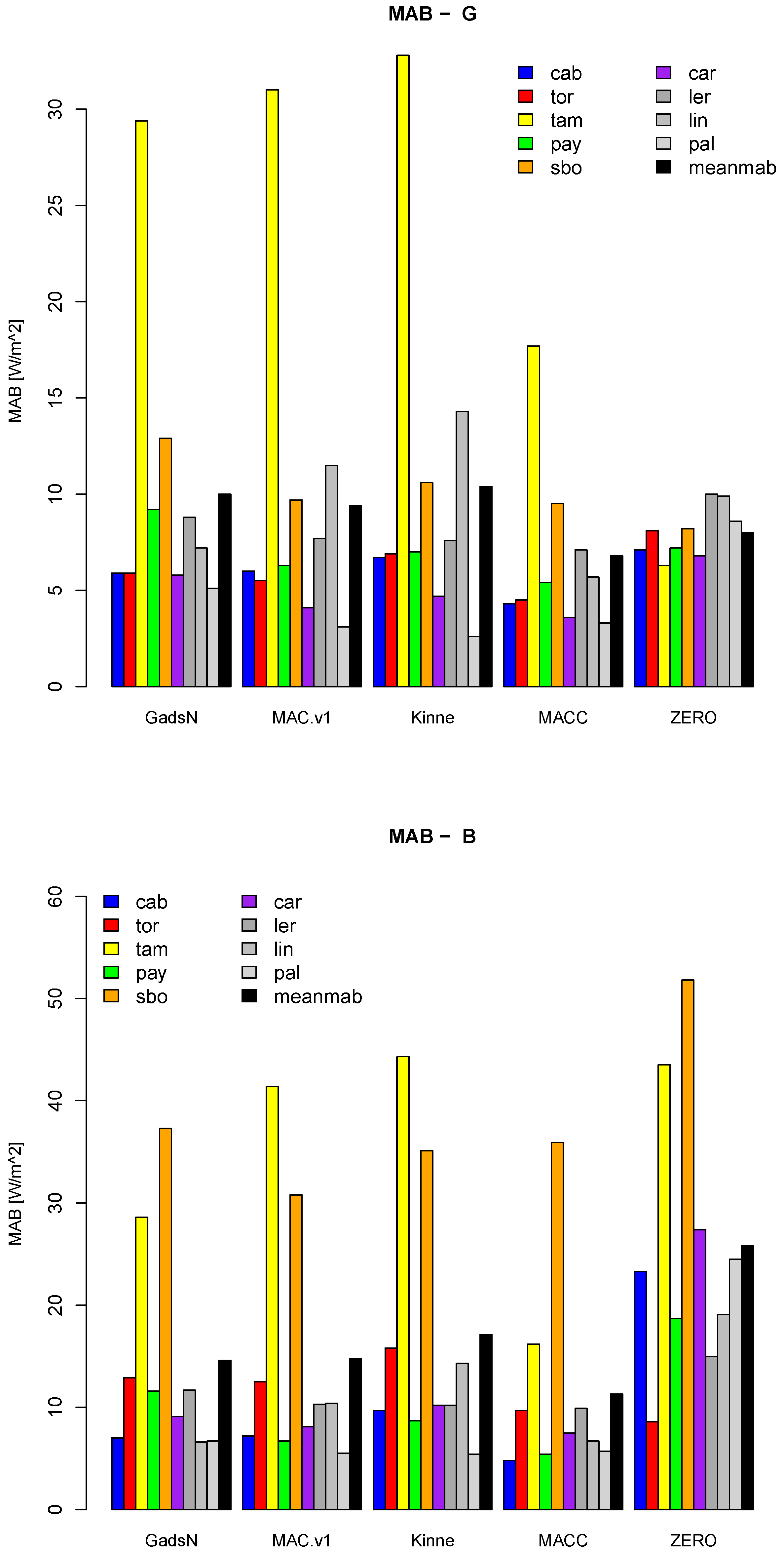
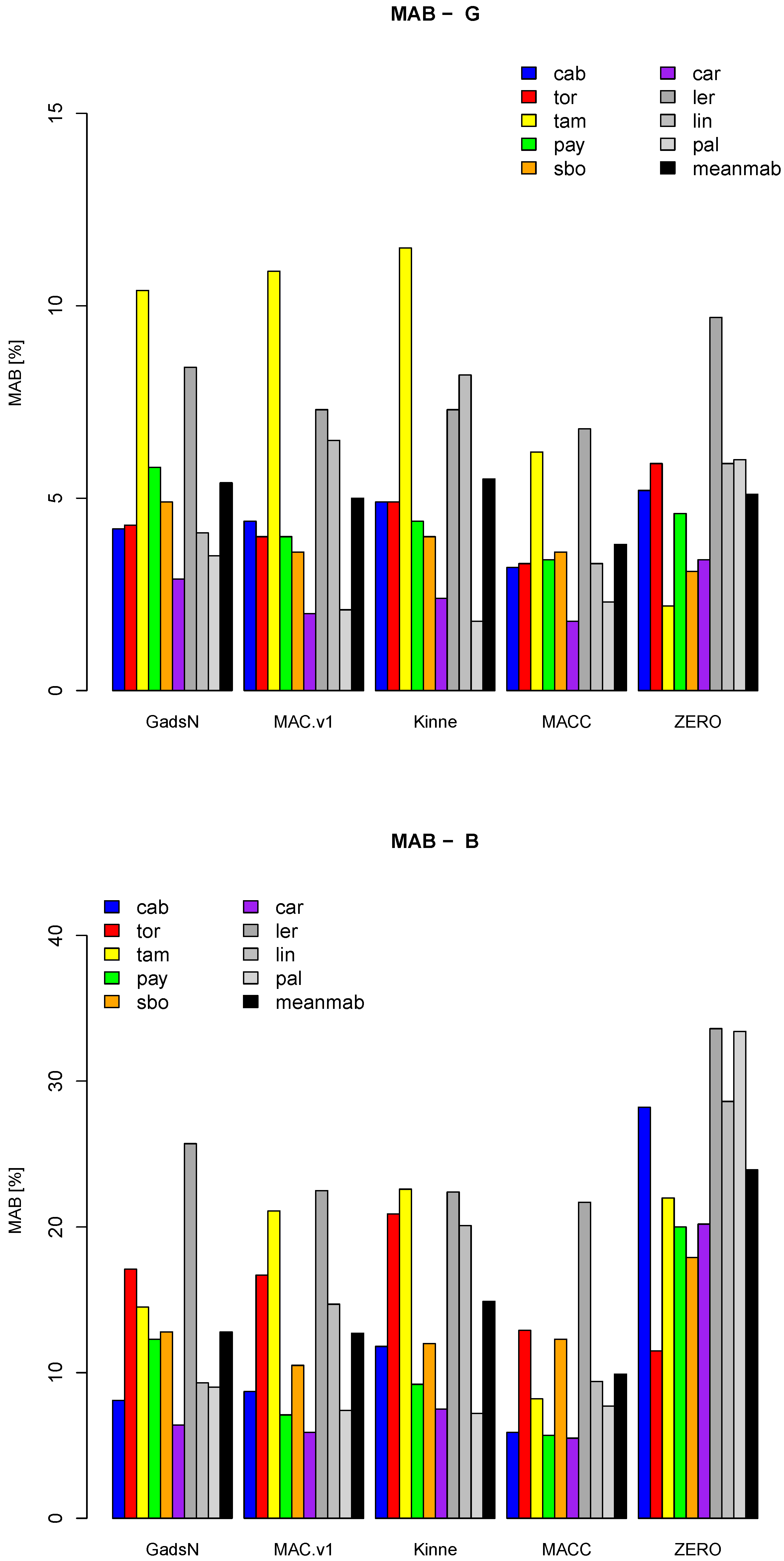
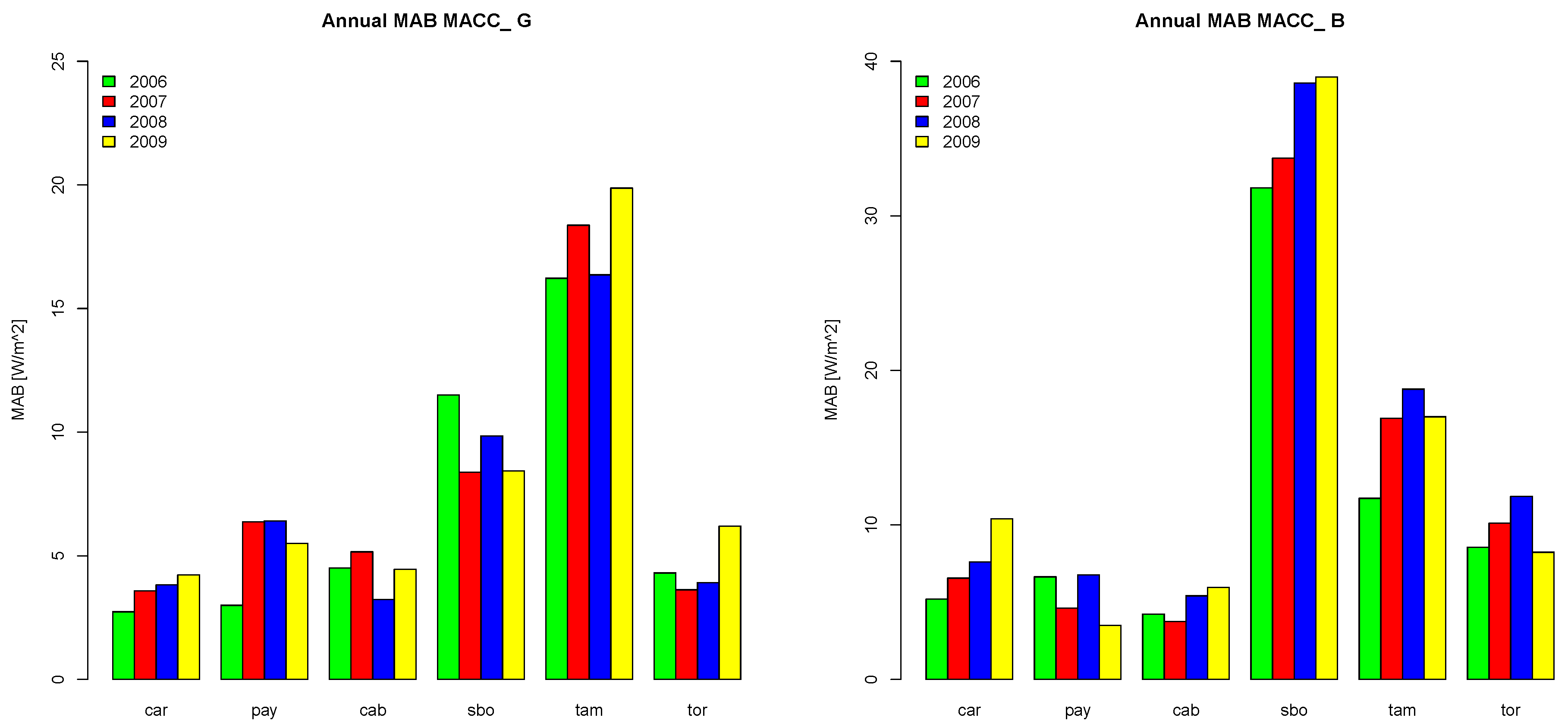
4. Conclusions
Acknowledgments
Author Contributions
Conflicts of Interest
References
- Dobler, A.; Müller, R.; Ahrens, B. Development and evaluation of a simple method to estimate evaporation from satellite data. Meteorol. Z. 2011, 20, 615–623. [Google Scholar] [CrossRef]
- Babst, F.; Mueller, R.; Hollmann, R. Verification of NCEP reanalysis shortwave radiation with mesoscale remote sensing data. Geosci. Remote Sens. Lett. 2008, 5, 34–38. [Google Scholar] [CrossRef]
- Träger-Chatterjee, C.; Mueller, R.W.; Trentmann, J.; Bendix, J. Evaluation of ERA-40 and ERA-interim re-analysis incoming surface shortwave radiation datasets with mesoscale remote sensing data. Meteorol. Z. 2010, 19, 631–640. [Google Scholar] [CrossRef]
- Hammer, A.; Heinemann, D.; Hoyer, C.; Kuhlemann, R.; Lorenz, E.; Mueller, R.; Beyer, H. Solar energy assessment using remote sensing technologies. Remote Sens. Environ. 2003, 86, 423–432. [Google Scholar] [CrossRef]
- Journée, M.; Müller, R.; Bertrand, C. Solar resource assessment in the Bebelux by merging Meteosat-derived climat data and ground measurements. Sol. Energy 2012, 86, 3561–3574. [Google Scholar] [CrossRef]
- Möser, W.; Raschke, E. Incident solar radiation over Europe estimated from METEOSAT data. J. Clim. Appl. Meteor. 1984, 23, 166–170. [Google Scholar] [CrossRef]
- Cano, D.; Monget, J.; Albuisson, M.; Guillard, H.; Regas, N.; Wald, L. A method for the determination of the global solar radiation from meteorological satellite data. Sol. Energy 1986, 37, 31–39. [Google Scholar] [CrossRef]
- Bishop, J.; Rossow, W. Spatial and temporal variability of global surface solar irradiance. J. Geophys. Res. 1991, 96, 839–858. [Google Scholar]
- Pinker, R.; Laszlo, I. Modelling surface solar irradiance for satellite applications on a global scale. J. Appl. Meteor. 1992, 31, 166–170. [Google Scholar] [CrossRef]
- Darnell, W.; Staylor, W.; Gupta, S.; Ritchey, N.; Wilber, A. Seasonal variation of surface radiation budget derived from ISCCP-C1 data. J. Geophys. Res. 1992, 97, 15741–15760. [Google Scholar] [CrossRef]
- Rigolier, M.; Levefre, M.; Wald, L. The method Heliosat-2 for deriving shortwave solar radiation from satellite images. Sol. Energy 2004, 77, 159–169. [Google Scholar] [CrossRef]
- Mueller, R.; Matsoukas, C.; Gratzki, A.; Hollmann, R.; Behr, H. The CM-SAF operational scheme for the satellite based retrieval of solar surface irradiance-a LUT based eigenvector hybrid approach. Remote Sens. Environ. 2009, 113, 1012–1022. [Google Scholar] [CrossRef]
- Kinne, S.; Schulz, M.; Textor, C.; Guibert, S.; Balkanski, Y.; Bauer, S.E.; Berntsen, T.; Berglen, T.F.; Boucher, O.; Chin, M.; et al. An AeroCom initial assessment-optical properties in aerosol component modules of global models. Atmos. Chem. Phys. 2006, 6, 1815–1834. [Google Scholar] [CrossRef]
- Gueymard, C.A. Temporal variability in direct and global irradiance at various time scales as affected by aerosols. Sol. Energy 2012, 86, 3544–3553. [Google Scholar] [CrossRef]
- Geiger, B.; Meurey, C.; Lajas, D.; Franchisteguy, L.; Carrer, D.; Roujean, J. Near real-time provision of downwelling shortwave radiation estimates derived from satellite observations. Meteorol. Appl. 2008, 15, 411–420. [Google Scholar] [CrossRef]
- Ineichen, P.; Barroso, C.; Geiger, B.; Hollmann, R.; Mueller, R. Satellite application facilities irradiance products: Hourly time step comparison and validation. Int. J. Remote Sens. 2009, 30, 5549–5571. [Google Scholar] [CrossRef]
- Fontoynont, M.; Dumortier, D.; Heinemann, D.; Hammer, A.; Olseth, J.; Skartveit, A.; Ineichen, P.; Reise, C.; Page, J.; Roche, L.; et al. Satellight: An European Programme Dedicated to Serving Daylight Data Computed from Meteosat Images. Available online: http://www.satellight.com/indexgT.htm (accessed on 25 November 2014).
- Wald, L.; Albuisson, M.; Best, C.; Delamare, C.; Dumortier, D.; Gaboardi, E.; Hammer, A.; Heinemann, D.; Kift, R.; Kunz, S.; et al. SoDa: A project for the integration and exploitation of networked solar radiation databases. In Environmental Communication in the Information Society; Pillmann, W., Tochtermann, K., Eds.; Number Part 2; International Society for Environmental Protection: Vienna, Austria, 2002; pp. 713–720. [Google Scholar]
- Huld, T.; Müller, R.; Gambardella, A. A new solar radiation database for estimating PV performance in Europe and Africa. Sol. Energy 2012, 86, 1803–1815. [Google Scholar] [CrossRef]
- The Climate Monitoring Satellite Application Facillity (CM-SAF). Available online: www.cmsaf.eu (accessed on 28 November 2014).
- Mueller, R.; Trentmann, J.; Träger-Chatterjee, C.; Posselt, R.; Stöckli, R. The role of the effective cloud Albedo for climate monitoring and analysis. Remote Sens. 2011, 3, 2305–2320. [Google Scholar] [CrossRef]
- Mueller, R.; Behrendt, T.; Hammer, A.; Kemper, A. A new algorithm for the satellite-based retrieval of solar surface irradiance in spectral bands. Remote Sens. 2012, 4, 622–647. [Google Scholar] [CrossRef]
- Mayer, B.; Kylling, A. Technical note: The libRadtran software package for radiative transfer calculations—Description and examples of use. Atmos. Chem. Phys. 2005, 5, 1855–1877. [Google Scholar] [CrossRef]
- Shettle, P.; Fenn, R.W. Models of the atmospheric aerosols and their optical properties. In AGARD Conference Proceedings No. 183, Optical propagation in the atmosphere, Symposium, Lyngby, Oct. 1975, 1976.
- Shetlle, E. Models of aerosols, clouds and precipitation for atmospheric propagation studies. In Proceedings of AGARD Conference No. 454, Atmospheric Propagation in the UV, Visible, IR and MM-region and Related System Aspects, Copenhagen, Denmark, 9–13 October 1989.
- Posselt, R.; Mueller, R.; Stöckli, R.; Trentmann, J. Spatial and temporal homogeneity of solar surface irradiance across satellite generations. Remote Sens. 2011, 3, 1029–1046. [Google Scholar] [CrossRef]
- Mueller, R.; Dagestad, K.; Ineichen, P.; Schroedter-Homscheidt, M.; Cros, S.; Dumortier, D.; Kuhlemann, R.; Olseth, J.; Piernavieja, G.; Resie, C.; et al. Rethinking satellite based solar irradiance modelling. The SOLIS clear-sky module. Remote Sens. Environ. 2004, 91, 160–174. [Google Scholar] [CrossRef]
- Holben, B.N.; Eck, T.F.; Slutsker, I.; Tanré, D.; Buis, J.P.; Setzer, A.; Vermote, E.; Reagan, J.A.; Kaufman, Y.J.; Nakajima, T.; et al. AERONET—A federated instrument network and data archive for aerosol characterization. Remote Sens. Environ. 1998, 66, 1–16. [Google Scholar] [CrossRef]
- Kinne, S.; O’ Donnel, D.; Stier, P.; Kloster, S.; Zhang, K.; Schmidt, H.; Rast, S.; Giorgetta, M.; Eck, T.F.; Stevens, B. MAC-v1: A new global aerosol climatology for climate studies. J. Adv. Model. Earth Syst. 2013, 5, 707–740. [Google Scholar] [CrossRef]
- FTP Server: The HACv1 aerosol data is available at the ftp server ftp-projects.zmaw.de in the directory aerocomclimatologyHACv1_2013.
- Hess, M.; Koepke, P.; Schult, I. Optical properties of aerosols and clouds: The software package OPAC. Bull. Amer. Meteor. Soc. 1998, 79, 831–844. [Google Scholar] [CrossRef]
- Kalnay, E.; Kanamitsu, M.; Kistler, R.; Collins, W.; Deaven, D.; Gandin, L.; Iredell, M.; Saha, S.; White, G.; Woollen, J.; et al. The NCEP/NCAR 40-year reanalysis project. Bull. Am. Meteorol. Soc. 1996, 77, 437–471. [Google Scholar] [CrossRef]
- Inness, A.; Baier, F.; Benedetti, A.; Bouarar, I.; Chabrillat, S.; Clark, H.; Clerbaux, C.; Coheur, P.; Engelen, R.; Errera, Q.; et al. The MACC reanalysis: An 8 year data set of atmospheric composition. Atmos. Chem. Phys. 2013, 13, 4073–4109. [Google Scholar] [CrossRef] [Green Version]
- Morcrette, J.J.; Boucher, O.; Jones, L.; Salmond, D.; Bechtold, P.; Beljaars, A.; Benedetti, A.; Bonet, A.; Kaiser, J.W.; Razinger, M.; et al. Aerosol analysis and forecast in the European centre for medium-range weather forecasts integrated forecast system: Forward modeling. J. Geophys. Res. 2009, 114. [Google Scholar] [CrossRef]
- Benedetti, A.; Morcrette, J.J.; Boucher, O.; Dethof, A.; Engelen, R.; Fisher, M.; Flentje, H.; Huneeus, N.; Jones, L.; Kaiser, J.; et al. Aerosol analysis and forecast in the European centre for medium-range weather forecasts integrated forecast system: 2. Data assimilation. J. Geophys. Res. 2009, 114. [Google Scholar] [CrossRef]
- Bellouin, N.; Quaas, J.; Morcrette, J.J.; Boucher, O. Estimates of aerosol radiative forcing from the MACC re-analysis. Atmos. Chem. Phys. 2013, 13, 2045–2062. [Google Scholar] [CrossRef] [Green Version]
- Ohmura, A.; Dutton, E.; Forgan, B.; Fröhlich, C.; Hegner, H.; Heimo, A.; König-Langlo, G.; Mc Arthur, B.; Müller, G.; Philipopon, R.; et al. Baseline Surface Radiation Network (BSRN/WCRP): New precision radiometry for climate research. Bull. Am. Met. Soc. 1998, 79, 2115–2136. [Google Scholar] [CrossRef]
- Müller, R. Solar irradiance, global distribution. In Encyclopedia of Sustainable Science and Technology; Meyers, R.A., Ed.; Springer: Berlin, Germany, 2012; Volume 1, pp. 9699–9729. [Google Scholar]
- Nikitidou, E.; Kazantzidis, A.; Salamalikis, V. The aerosol effect on direct normal irradiance in Europe under clear skies. Renew. Energ. 2014, 68, 475–484. [Google Scholar] [CrossRef]
© 2014 by the authors; licensee MDPI, Basel, Switzerland. This article is an open access article distributed under the terms and conditions of the Creative Commons Attribution license (http://creativecommons.org/licenses/by/4.0/).
Share and Cite
Mueller, R.; Träger-Chatterjee, C. Brief Accuracy Assessment of Aerosol Climatologies for the Retrieval of Solar Surface Radiation. Atmosphere 2014, 5, 959-972. https://doi.org/10.3390/atmos5040959
Mueller R, Träger-Chatterjee C. Brief Accuracy Assessment of Aerosol Climatologies for the Retrieval of Solar Surface Radiation. Atmosphere. 2014; 5(4):959-972. https://doi.org/10.3390/atmos5040959
Chicago/Turabian StyleMueller, Richard, and Christine Träger-Chatterjee. 2014. "Brief Accuracy Assessment of Aerosol Climatologies for the Retrieval of Solar Surface Radiation" Atmosphere 5, no. 4: 959-972. https://doi.org/10.3390/atmos5040959




